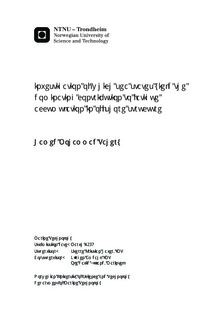| dc.description.abstract | In assessment of the fatigue damage, it has been assumed that the moderate sea states (significant wave height ranged between 4-8m) should have major influence on the offshore structures because they have relatively more frequent occurrences than the higher sea state and have much severe effect than the lower sea states.
Despite of all the expectations, the accumulative fatigue damage calculated by Ole David Økland for two large storm events, claims that the dominating fatigue damage is caused due to higher sever sea states (significant wave height ranged between 9-13m). This result is based on the measured responses of the Kvitebjørn platform.
The purpose of this thesis is to investigate fatigue accumulation for every 3 hour period during 1957-2011, versus sea state severity. All these data have been performed in a omnidirectional scatter diagram and almost all the sea states with H_S≥5 meter have been included in the calculations.
Due to the relatively high height of this specific jacket (190 m), the equation of motion has been solved by time domain analysis approach using USFOS. Moreover, the global FEM analysis has been done and the nominal stresses at each end of the braces are calculated.
In order to find local stresses and furthermore the fatigue damage at each end, the nominal stresses and the stress concentration factors alongside the two slope S-N curve introduced to the utility tool for fatigue estimation, called FATAL. Using rainflow counting method, FATAL s output involves two different types of data, the accumulative damage for each brace and the histogram of the stress ranges versus number of cycles.
The stress range values have been fitted to the Weibull probability paper plot and the Weibull parameters are obtained for each sea state. At the end the fatigue damages have been calculated by using the closed form equation.
The results obtained by both approaches indicate that the sea states with the highest probability of exceedance (i.e. 7.5≤H_S ≤9.5 ) have the dominating contribution in accumulative fatigue damage. | |

